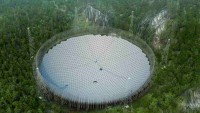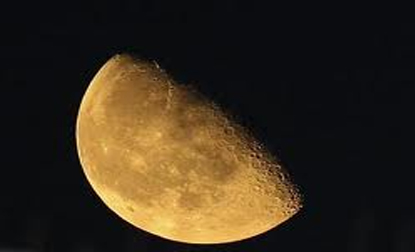China’s involvement in modern astronomy is moving quietly, steadily
| Eana Maniebo | | Oct 16, 2015 09:08 AM EDT |
(Photo : Collect Space) Launch of Shenzhou VII.
The lenses of the first antimatter telescope
Optician Jianmin Guo from China designed the concave lenses of the Santilli Telescope, the world's first telescope that proved the existence of antimatter galaxies, cosmic rays, and asteroids. Created by Dr. Ruggero Santilli of Thunder Energies Corporation (OTCQB: TNRG), one of the industry leaders in breakthrough technological equipment, the Santilli Telescope is the first with concave lenses in all of mankind's history that allowed for the first confirmed detection of antimatter galaxies, cosmic rays, and asteroids.
Like Us on Facebook
The revolutionary design of the concave lenses were implemented by Guo's company, Zhengzhou Union Optics Co. LTD. Thunder Energies shipped one of two custom-made Galileo telescopes, along with specifications on the conversion of its two lenses. Zhengzhou was tasked with the transformation of the telescope from the Galileo form with 100 mm effective convex primary lenses, to the antimatter telescope.
The Santilli telescope, whose features are identical to those the Galileo has but are now conjugated, enabled the scientists at Thunder Energies to detect several antimatter sky objects. Confirmations of these detections allow for possible proving and disproving of existing theories, as well as harnessing antimatter in space for energy.
The first probe to land on the Moon's far side
After Chang'e 3 was revealed to have been on the moon's Mare Imbrium region since December 2013, China will follow up with Chang'e 4 for what will be the first touchdown on the lunar far side by the end of the decade. The Chang'e 4 landing probe, which will be launched in 2018, will carry more science payloads than the Chang'e 3 mission.
The same face of the moon is visible from the Earth. Its far side, which is heavily cratered and rougher than the lunar near side, will require the launch of an additional spacecraft to relay signals between the lander and Earth. Chang'e 4 will land in a gravity-stable location called the Earth-Moon L2 point in the far side of the Moon.
The goal of Chang'e 4 is to study geologic conditions and low-frequency radio waves. The far side of the Moon has a clean electromagnetic environment, which provides an ideal field for low-frequency radio study.
The largest radio telescope partnered with fastest supercomputer
China's military-led space program is constructing the world's largest radio telescope, the Five-hundred-meter Aperture Spherical Telescope (FAST). The Chinese state media recently released images of the gigantic structure that showed the dish itself with the size of 30 football pitches. FAST will be able to detect radio signals-and potentially, signs of life-from as far as tens of billions of light years away. China's state-run Xinhua news agency says FAST will be completed in 2016.
No ordinary computer can handle the data collected by the world's largest radio telescope. To support its capacity, FAST will be connected to what will be the fastest computer, South China Morning Post reported. This pairing will allow for astronomical calculations as it searches for alien life and investigates dark matter.
The Sky Eye 1 will be FAST's "super brain." It will beat the current fastest astronomical supercomputer, Japan's Aterui. To process the enormous amount of data from the project, Sky Eye 1's expected peak performance will be above Aterui's 1,000 teraflops, or one thousand trillion calculations per second.
The supercomputer will be hosted at a facility near the telescope and will be connected with a high-speed data link. The link is capable of transmitting up to 100 gigabytes of data per second.
TagsChina space program, Chang'e-3, Chang'e-4, Chang'e-5, change, FAST, World's biggest telescope, Five hundred meter aperture spherical telescope, Sky Eye 1, Japan's Aterui, Supercomputer, telescope, Santilli telescope, Jianmin Guo, Zhengzhou Union Optics Co. Ltd., Thunder Energies, Thunder Energies Corporation, Ruggero Santilli
©2015 Chinatopix All rights reserved. Do not reproduce without permission
 China Builds Largest Telescope in the World
China Builds Largest Telescope in the World China-U.S. Agree to Cyberspace Rules of Conduct and Promise to Cease Economic Spying
China-U.S. Agree to Cyberspace Rules of Conduct and Promise to Cease Economic Spying Satellite Image of China's Completed Airstrip in Disputed South China Sea Reef Surfaces as President Xi Vows No Militarization of Islands
Satellite Image of China's Completed Airstrip in Disputed South China Sea Reef Surfaces as President Xi Vows No Militarization of Islands China's Space Program: China to Land on the Dark Side of the Moon
China's Space Program: China to Land on the Dark Side of the Moon
EDITOR'S PICKS
-

Did the Trump administration just announce plans for a trade war with ‘hostile’ China and Russia?
-

US Senate passes Taiwan travel bill slammed by China
-

As Yan Sihong’s family grieves, here are other Chinese students who went missing abroad. Some have never been found
-

Beijing blasts Western critics who ‘smear China’ with the term sharp power
-

China Envoy Seeks to Defuse Tensions With U.S. as a Trade War Brews
-

Singapore's Deputy PM Provides Bitcoin Vote of Confidence Amid China's Blanket Bans
-

China warns investors over risks in overseas virtual currency trading
-

Chinese government most trustworthy: survey
-

Kashima Antlers On Course For Back-To-Back Titles
MOST POPULAR
LATEST NEWS
Zhou Yongkang: China's Former Security Chief Sentenced to Life in Prison

China's former Chief of the Ministry of Public Security, Zhou Yongkang, has been given a life sentence after he was found guilty of abusing his office, bribery and deliberately ... Full Article
TRENDING STORY

China Pork Prices Expected to Stabilize As The Supplies Recover

Elephone P9000 Smartphone is now on Sale on Amazon India

There's a Big Chance Cliffhangers Won't Still Be Resolved When Grey's Anatomy Season 13 Returns

Supreme Court Ruled on Samsung vs Apple Dispute for Patent Infringement

Microsoft Surface Pro 5 Rumors and Release Date: What is the Latest?










